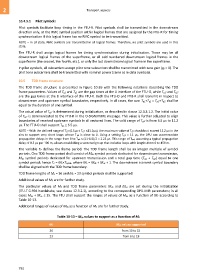Page 802 - 5G Basics - Core Network Aspects
P. 802
2 Transport aspects
10.4.5.1 Pilot symbols
Pilot symbols facilitate loop timing in the FTU-R. Pilot symbols shall be transmitted in the downstream
direction only, at the RMC symbol position within logical frames that are assigned by the FTU-R for timing
synchronization if this logical frame has no RMC symbol to be transmitted.
NOTE – In L0 state, RMC symbols are transmitted in all logical frames. Therefore, no pilot symbols are used in this
state.
The FTU-R shall assign logical frames for timing synchronization during initialization. Those may be all
downstream logical frames of the superframe, or all odd numbered downstream logical frames in the
superframe (the second, the fourth, etc.), or only the last downstream logical frame in the superframe.
In pilot symbols, all subcarriers except pilot tone subcarriers shall be transmitted with zero gain (gi = 0). The
pilot tone subcarriers shall be transmitted with nominal power (same as in data symbols).
10.5 TDD frame structure
The TDD frame structure is presented in Figure 10-26 with the following notations describing the TDD
frame parameters. Values of Tg1 and Tg2 are the gap times at the U interface of the FTU-O, while Tg1' and Tg2'
are the gap times at the U interface of the FTU-R. Both the FTU-O and FTU-R shall transmit in respect to
downstream and upstream symbol boundaries, respectively. In all cases, the sum Tg1+Tg2 = Tg1'+Tg2' shall be
equal to the duration of one symbol.
The actual value of Tg1' is determined during initialization, as described in clause 12.3.3.1.2. The initial value
of Tg1' is communicated to the FTU-R in the O-SIGNATURE message. This value is further adjusted to align
boundaries of received upstream symbols in all vectored lines. The valid range of Tg1' is from 6.5 μs to 11.2
μs. The FTU-O shall support Tg1 ≥ 6.5 μs.
NOTE – With the defined range of Tg1' (6.5μs ≤ Tg1' ≤11.2μs), the maximum value of Tg2 should not exceed 11.2 μs in the
aim to support very short loops whose Tpd is close to 0. Using a setting Tg2 = 11 μs, the DPU can accommodate
propagation delays in the range from 0 to Tpd ≤ (11-6.5)/2 = 2.25 μs. This range of Tpd, assuming a typical propagation
delay of 0.5 μs per 100 m, allows establishing a vectored group that includes loops with lengths from 0 to 450 m.
The variable TF defines the frame period. The TDD frame length shall be an integer multiple of symbol
periods. One TDD frame period shall consist of Mds symbol periods dedicated for downstream transmission,
Mus symbol periods dedicated for upstream transmission and a total gap time (Tg1 + Tg2) equal to one
symbol period; hence TF = MF×Tsymb, where MF = Mds + Mus + 1. The downstream transmit symbol boundary
shall be aligned with the TDD frame boundary.
TDD frame lengths of MF = 36 and MF = 23 symbol periods shall be supported.
Additional values of MF are for further study.
The particular values of MF and TDD frame parameters Mds and Mus are set during the initialization
(ITU-T G.994 handshake, see clause 12.3.2.1), according to the corresponding DPU-MIB parameters; in all
cases Mds + Mus ≤ 35. The FTU shall support the ranges of values of Mds as a function of MF according to
Table 10-13.
Additional ranges of values of Mds as a function of MF are for further study.
Table 10-13 – Mds values to support as a function of MF
MF Mds values supported
36 from 10 to 32
23 from 6 to 19
792

